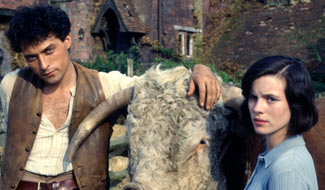 Cold Comfort Farm is the amusing story of Flora Poste, a sensible young woman from London who goes to live with relatives in Sussex, the eccentric Starkadders.
Cold Comfort Farm is the amusing story of Flora Poste, a sensible young woman from London who goes to live with relatives in Sussex, the eccentric Starkadders.
The author, Stella Gibbons, had grown up among weird relations. When she was just eleven she had to talk her father out of committing suicide, and was astonished to realize that he was actually relishing their melodramatic conversation. Her family seemed partial to creating scenes, but with a clear thread of pretence running through their ‘performances’.
Gibbons felt that the genre of the rural novel – ‘The Loam and Lovechild School of Fiction’ - had run its course and offered itself to parody. Writers such as Mary Webb irritated her, so she offered an alternative vision of country living. Stock characters – the religious bigot, the overbearing matriarch, the local Lothario etc. – were reinvented. There are passages which mock the style of D.H. Lawrence: note, for example, the characters Mr Mybug and Seth Starkadder.
Reference to Cold Comfort Farm usually triggers the famous quote that there was ‘something nasty in the woodshed’. Aunt Ada Doom claims to have seen it when she was ‘no bigger than a titty wren’. Gibbons would never reveal what the ‘something nasty’ was; but it represents childhood trauma, whether real or imagined, and the way its ‘victims’ use it to excuse their behaviour.
The novel contains delicious examples of local dialect and of parodied rural expressions. Kenneth Williams read the book on the radio, and this must have been wonderful to hear!
Share your views in the comments box below.
Rate and Review
Rate this article
Review this article
Log into OpenLearn to leave reviews and join in the conversation.
Article reviews